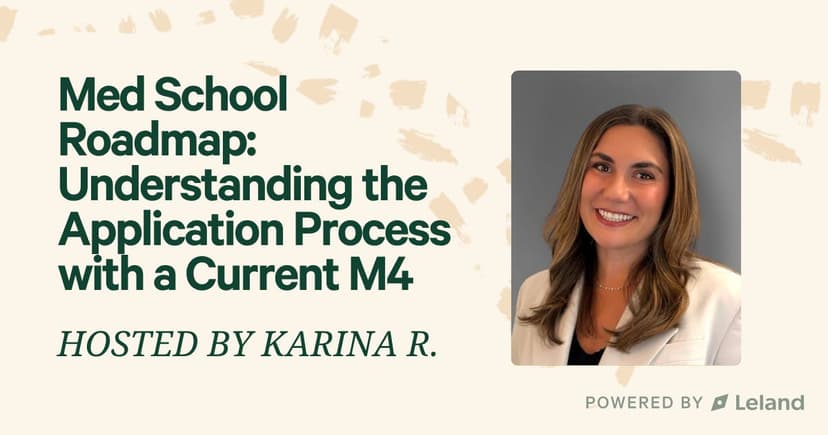How to Get Into Medical School With a Low MCAT Score
Yes, you can get into med school with the lowest MCAT score accepted. Learn how to strengthen your app, choose the right schools, and stand out.

By Krysta F.
Posted October 2, 2025

Join a free event
Learn from top coaches and industry experts in live, interactive sessions you can join for free.
Table of Contents
If you’re staring at a lower-than-you-hoped MCAT score, you’re not alone, and you’re not out of the running.
Hi, I’m Krysta F. I’ve worked with dozens of medical school applicants who’ve been in this exact spot. Your MCAT score can feel like it defines your entire future. But it doesn’t. It’s one part of your story, and medical school admissions committees know that.
In this article, I’ll walk you through what a “low” MCAT actually means, how to build a successful application around it, what types of med schools are more flexible, and how to know if retaking the exam is worth it. I’ll also share what I’ve seen work for real students accepted with below-average MCAT scores, plus insight from current med students who’ve been in your shoes.
Let’s get started.
What Counts as a Low MCAT Score?
The term “low” is relative. For most medical schools, a low MCAT score generally means anything below 500, which is around the national average. But that’s not a hard cutoff.
A 500 puts you in about the 45th percentile among medical college admissions test takers, while a 490 is around the 20th. Some schools have a minimum MCAT score requirement, while others focus on your full academic and personal profile.
A “low” score could be:
- Below the median MCAT score for a specific school of medicine
- Below your target schools' published average
- Out of sync with your GPA (e.g., low MCAT but high GPA)
The median score for U.S. medical schools tends to hover around 511, but the lowest MCAT score accepted at some institutions can dip into the high 480s, especially for mission-based programs or osteopathic schools.
Remember: A low MCAT doesn’t mean no chance. It just means you need a strategy.
Can You Still Get Into Medical School With a Low MCAT?
Yes! Most medical school admissions committees use a holistic review process. That means they’re not just looking at your MCAT score or your GPA; they’re considering your academic records, personal statement, experiences, and fit for the school’s mission.
Here’s how students with a low MCAT get in:
- They pair that score with a high GPA (especially in science courses)
- They demonstrate deep, consistent clinical experience and patient exposure
- Their personal statement tells a clear, compelling story of growth and purpose
- Their letters of recommendation vouch for academic ability and character
- They apply early, broadly, and target medical schools where their mission fits
- They often highlight upward academic trends or success in rigorous coursework
- Many apply to DO programs, which tend to have a lower minimum MCAT score but equally high standards for future physicians
Schools That Accept Lower MCAT Scores
If your score is below average, you’ll want to be extra thoughtful about where you apply.
DO vs. MD Schools
DO schools tend to be more flexible with stats. They focus heavily on mission alignment, service, and resilience, especially for applicants committed to serving underserved communities or pursuing primary care.
Here are DO schools where the lowest MCAT score accepted is 496 or below:
- Edward Via College of Osteopathic Medicine (VCOM) - Average MCAT: ~500; Minimum reported: 496.
- Idaho College of Osteopathic Medicine (ICOM) - Average MCAT: ~503; Accepts applicants in the 490s.
- Arkansas College of Osteopathic Medicine (ARCOM) - Accepts MCAT scores as low as 494.
- Alabama College of Osteopathic Medicine (ACOM) - Minimum MCAT considered: 495
- Liberty University College of Osteopathic Medicine (LUCOM) - Average MCAT ~501; Range includes sub-500 scores.
- Burrell College of Osteopathic Medicine (New Mexico school) - Accepts students in the high 480s with strong GPAs and mission alignment.
These schools are great for applicants with strong clinical backgrounds and alignment with rural or underserved community service.
For more on this, check out: DO vs. MD: Degree Differences in Education, Jobs & Salary
Mission-Driven MD Programs
Some MD schools prioritize holistic admissions and may consider applicants with a minimum score in the mid-to-high 490s, particularly if you bring something compelling to the table.
Examples include:
- Howard University College of Medicine - Focus on training physicians who will serve medically underserved communities.
- Meharry Medical College - Historically Black medical school committed to primary care and equity.
- University of New Mexico School of Medicine - Prioritizes in-state and rural applicants; MCATs in the mid-to-high 490s are considered.
- Drew/UCLA Medical Education Program - Mission-driven; supports underserved and marginalized populations.
- Fertitta Family College of Medicine (University of Houston) - Community-based, holistic-focused admissions.
Check the AAMC MSAR for each school’s average MCAT score, lowest median MCAT score, and accepted ranges.
International or Caribbean Med Schools
These are sometimes considered a last resort, but they do accept students with the lowest MCAT scores (often in the 470–490 range). If you go this route, research carefully. Pay attention to:
- USMLE Step 1 pass rates
- Residency match rates
- Student support and infrastructure
Examples include:
- St. George’s University (Grenada)
- Ross University School of Medicine (Barbados)
- American University of the Caribbean (AUC)
- Saba University School of Medicine
Strategies to Strengthen the Rest of Your Application
If your MCAT score isn’t your strongest asset, everything else needs to shine.
A high GPA is your academic anchor
If your MCAT score is underwhelming, a strong GPA, especially in upper-level science courses, can completely change how admissions committees see you. A 3.8+ paired with a sub-500 MCAT shows that you can handle a full course load and perform consistently over time. According to the GPA MCAT grid from the Association of American Medical Colleges, students with 3.8 GPAs and MCATs in the 490s still see acceptance rates between 20–30% at many medical schools. If your GPA is lower, consider postbacc or SMP programs to prove academic readiness.
Gain clinical hours that show you’re already in the trenches
Numbers can’t capture your presence in a hospital room, but your experiences can. Hundreds of hours in real patient-care settings like community clinics, emergency departments, or hospices can show medical school admissions committees that you're not just guessing what the job looks like. You’ve lived it. Bonus if you can reflect on what those moments taught you and how they shaped your desire to serve. Shadowing physicians (especially in primary care or underserved settings) also adds depth and signals curiosity and initiative.
Showcase leadership that goes beyond a title
Too many applicants list generic extracurricular activities. What matters is impact. Did you lead a student health org and build new programs? Did you mentor underrepresented premeds or launch a service project in your community? These are the kinds of experiences that show initiative, follow-through, and character. When your MCAT score is below average, your leadership can’t just be passive; it needs to reflect real ownership, creativity, and service.
Your personal statement can do heavy lifting if you let it
This is the core of your story, and if you have a low MCAT score, your personal statement (and secondaries) are where you pivot. Acknowledge the score briefly. Then move on quickly to what you’ve learned, how you’ve grown, and how you’ve shown up in difficult environments. Make it clear you’re not trying to hide your weaknesses, you’re owning them, learning from them, and showing what kind of physician they’re shaping you to become. Reinforce your motivation for medicine and connect the dots between your values, experiences, and long-term goals.
Let your recommenders vouch for you behind the stats
When one number might raise questions, a powerful letter of recommendation can quiet them. You want letters from people who know your academic ability, but also your work ethic, integrity, and empathy. Strong letters often come from faculty who’ve seen you struggle and grow, or clinicians who’ve worked with you closely. They can speak to the traits that don’t show up in your MCAT score, and often those are the traits that matter most in medicine.
How To Tie Your Story Together And Show Growth
One number doesn’t define your future, but your story can. If your MCAT score is low, acknowledge it briefly, then pivot to growth. Show how challenges shaped you: whether through tougher coursework, improved study habits, or renewed focus. Let your clinical, research, and volunteer experiences reflect not just activity, but learning and purpose.
Your personal statement is where it all connects. Use it to highlight your “why,” frame your journey with honesty and intention, and show that you’re ready.
Own your story. Growth, grit, and clarity matter more than perfection ever could.
If you want helpful feedback on your story, book a free call with me to review your application strategy. I’ll help you position your strengths, pick the right MD or DO programs, and decide if a retake is necessary.
Retake or Not? When It Makes Sense to Try Again
| Retake Makes Sense If… | Be Cautious About Retaking If… |
|---|---|
| You scored significantly below the median MCAT score (typically <500 for MD, <495 for DO). | Your score is within a few points of the average for your target schools, and your GPA is strong (e.g., 3.7+). |
| Your prep was incomplete. e.g., major content gaps, poor time management, or ineffective resources. | You’re retaking with the same prep strategy and hoping for a better result. |
| You had extenuating circumstances on test day, such as illness, family emergency, anxiety, etc. | You’re applying late in the cycle, and retaking will delay your submission past early deadlines. |
| You’ve done a diagnostic or practice test showing clear potential for a 5+ point improvement. | Your time would be better spent strengthening other parts of your application (e.g., clinical experience, essays, or LORs). |
| You’re targeting more competitive MD programs where your current score is clearly below their cutoff. | You’ve already taken the MCAT multiple times with minimal improvement. |
Most medical school admissions committees look at your highest score, but they also notice trends. A small increase (1–2 points) may not be worth the risk unless you can show a significant jump and clear growth.
Goal for retakers: Aim to improve by at least 3–5 points, especially if your current score is below 500. Focus on weak sections like critical analysis, biological and biochemical foundations, or timing under pressure.
Consider DO, SMP, or Postbacc Programs
If your MCAT score is low or your academic record needs a boost, these three pathways can dramatically improve your chances, but only if chosen strategically:
Osteopathic Medical Schools (DO Programs)
DO schools are often more holistic and flexible with stats, accepting students with lower average MCAT scores and placing stronger weight on service, character, and mission alignment. They're ideal for applicants drawn to primary care, rural health, or osteopathic medicine philosophies. And yes, DOs are fully licensed physicians in all 50 states with strong match outcomes.
Expert Tip: Many osteopathic medical schools publish minimum MCAT thresholds in the 490–500 range. Look closely at schools like VCOM, ICOM, or ARCOM if you’re below 500 but have strong experience and a GPA.
Special Master’s Programs (SMPs)
SMPs are one-year graduate-level programs housed within or affiliated with medical schools. You take med school-level science courses, often alongside actual medical students, and your performance becomes a direct signal to the admissions committee. These are best for students with a lower GPA or inconsistent academic record, but who are ready to prove they can handle the rigor.
Choose SMPs that link directly to a medical school and offer conditional acceptance or guaranteed interviews for strong performance.
Postbacc Programs
Ideal if you need to improve your GPA, complete premed requirements, or strengthen your academic foundation before applying. They typically don’t carry the same level of risk/reward as SMPs, but they’re valuable for building confidence, structure, and upward trends in your academic records. Make sure your postbacc includes advising and committee letters – some do, some don’t.
Application Tips for Low-MCAT Applicants
When your MCAT score is below average, how you apply becomes just as important as what you bring. Here’s a step-by-step strategy to improve your odds:
- Apply early and broadly: Timing can make or break your chances. A lower-MCAT applicant who submits in June stands a much better shot than someone with similar stats who applies in August. Submit your primary application as early as possible, and apply to a broad mix of schools, including DO programs, mission-driven MD schools, and those with lower median MCAT scores.
- Know the numbers, but don’t obsess: Use the AAMC MSAR and school websites to research each school’s average MCAT, median score, and 10th percentile range. If you're below the school’s minimum score, that’s likely a wasted application. But if you're within the lower end of the range, and your GPA, story, and experience are strong, you may be a competitive applicant, especially at schools that prioritize a holistic review process.
- Prioritize mission fit over prestige: Not all medical schools weigh MCAT scores the same. Focus on programs whose missions align with your background and values, especially those committed to primary care, rural health, or serving underserved communities. A strong fit can often outweigh a subpar score.
- Let your narrative lead the way: If numbers aren’t your strongest asset, your story must carry the weight. Your personal statement and secondaries should acknowledge your MCAT briefly, then shift focus to your academic growth, clinical readiness, and “why” for medicine. You’re not defined by a score, but your response to it says everything.
You Can Still Get Into Med School With a Low MCAT
Your MCAT score is one data point. It matters, but it’s not everything. What matters the most is how you show up: with purpose, with growth, and with a clear understanding of why you’re here. You absolutely can get into med school with a low MCAT. But you’ll need a smart strategy, a strong story, and the belief that one number doesn’t define your future.
Work With Me to Strengthen Your Application
If you’re applying with a low MCAT score, thinking about a retake, or unsure how to position your story, I’d love to help. I work with students every cycle who turn a rough test score into a powerful, purpose-driven application that gets results. You can book a free 1:1 session with me here.
And if you're still exploring options, you can also browse top-rated medical school coaches, find expert MCAT tutors, read student reviews, or schedule a call with a Leland advisor to get matched to your perfect coach.
Leland also offers free events, so anyone can refine their medical school application leveraging expert insights. Wherever you are in the process, you're not alone, and you're not out of options!
Read these next:
- The Different Types of Medical Careers – and Which One is Right for You
- DO vs. MD: Degree Differences in Education, Jobs & Salary
- How Long is Medical School – A Year-by-Year Breakdown
- The 20 Best Medical Schools in the US (T20): Acceptance Rates, MCAT Scores, & GPA
- How to Get Into Medical School: The Complete Guide
Low MCAT Score – FAQs
What’s the lowest MCAT score ever accepted?
- Some eight medical schools have accepted scores in the 480s. But it’s rare. Focus on schools where your full profile fits.
Should I apply this cycle with a low MCAT or wait and retake?
- If everything else is strong and you're not too far below the average score, apply. Otherwise, consider a retake with better prep.
Are DO schools easier to get into than MD programs?
- Statistically, yes. But they’re just as rigorous and respected, especially for those passionate about osteopathic medicine.
Can clinical experience really make up for a low MCAT?
- Yes. Many accepted students were admitted because of their depth of experience and maturity, not just numbers.
What is the lowest MCAT score accepted into medical school?
- The lowest MCAT scores accepted by medical schools can vary, but generally, MD programs accept scores starting around the lower 500s, with 500-503 being on the lower end.
Is it worth applying to a Mississippi school or Mexico school if my score is very low?
- Some state and international options have lower minimum score thresholds, but do your research. Don’t just chase stats.

Written by Krysta
5.0
(45)
Krysta's coaching approach prioritizes story-telling, demonstrating fit and alignment via competencies associated with graduate and professional school program. She has completed thousands of advising appointments with college students and young alumni, and yet still takes an individualized approach to each and every applicant that she works with, finding the motivations and experiences that bring out their best qualities, making their applications stand apart from the crowd. As an equity-based higher educational professional with expertise in student success and alumni engagement, Krysta leads career education efforts in a science-focused residential college at a large R1 University. Through strategic collaboration, and with a keen focus on inclusivity and equitable engagement, Krysta has created and implemented innovative programming both in and out of the classroom, identifying opportunities to combine resources and networks with campus partners in a way that supports student success. Most recently, her endeavors have included developing short and long-term alumni mentorship programs, primarily for pre-med and science students, as well as implementing career education into the core science curriculum. This work places a significant emphasis on improving access to career resources and mentorship for all students, especially those from marginalized backgrounds. In addition to creating and executing these programs, Krysta co-leads a research team which seeks to better understand how incorporating career education into the core curriculum impacts students’ sense of self-efficacy, STEM Identity, and sense of belonging, all of which contribute to retention.
Krysta has helped clients get into organizations like:
Browse hundreds of expert coaches
Leland coaches have helped thousands of people achieve their goals. A dedicated mentor can make all the difference.
















